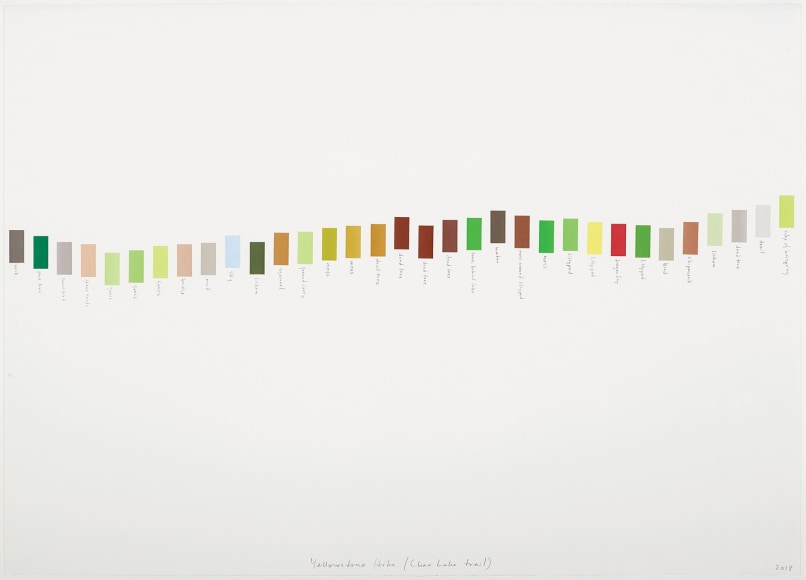Berggruen Gallery is pleased to present Spencer Finch, Me, Myself, and I (A Group Show), an exhibition of a wide range of media, including light-based sculpture, drawings, photographs, and prints by American artist, Spencer Finch. This show marks Finch’s first solo exhibition with the gallery and will be on view March 28 through May 5, 2018. The gallery will host a reception for the artist on Wednesday, March 28, 2018 from 5:00 to 8:00pm.
Spencer Finch, Me, Myself, and I (A Group Show) presents a selection of recent work as well as highlights of the past decade of Finch’s body of work, bringing together art created from 2008 to present. Finch is widely recognized for his work across a variety of media that captures the artist’s aesthetic probing of nature, human culture, and memory through a unique cross current of science, perception, and personal experience. Through Finch’s meticulous study of his surrounding environments, the artist emphasizes the profound visual cadence of the human eye in its ability to record and measure natural phenomena involving color and light. His commitment to capturing the evanescence of visual memories and the observed world ensues in careful studies of his surroundings that are both data-driven and informed by Finch’s personal captivation with nature and its myriad forms.
Often working in series, the artist turns to subjects grounded in a rich sense of place—the view from his studio window, a historic garden in Japan, his childhood bedroom—that reflect intimate moments of meditation, observation, and conjecture. Continually returning to specific sites, Finch investigates the visual evolution of seasons and the passing of time through a body of work that embraces a considerable range of aesthetic applications. His work offers an intimate lens by which the nature of the observed world is distilled into pivotal moments of visual and scientific analysis. In Ice Drawing (Fox Glacier, NZ), Finch renders the stages of a melting glacier in New Zealand by melting layers of dyed ice onto paper. Perceived physical transformations also manifest in Finch’s unique color studies. Yellowstone Hike (Clear Lake Trail) captures the essence of the artist’s encounter with nature through a unique narration comprised of each visual component of the trail—rocks, mud, sky, moss, bridge—and its corresponding Pantone swatch of color.
Time-based measurements combined with the artist’s singular observations capture a vast spectrum of optical sensitivities. Patiently following natural courses of movement over a period of time, Finch produces an art form embedded with a profound spirit of place, conjuring a philosophical consciousness rooted in the intimacy between the artist and his subject. In Following a Bee (Zinnias), Finch patiently observes and records the unpredictable, sinuous pattern of a bee migrating between flowers. Before crafting the work on paper, the artist designed and planted a garden from seeds specifically meant for the creation of the series. Finch describes the garden as his own “laboratory for making art.” Similarly, the rhythmic curvature of his line drawings such as Falling Leaves (maple) recalls meteorological drawings charting nature’s variable path.
Throughout his work, Finch incorporates video recordings, acetate tracings, and GPS to capture the specificity of nature’s movements. The artist subsequently interprets and translates this data through a profusion of art forms embedded with allusions to personal memories or references to art, culture, and history. Finch turned to the poetry of W.H. Auden and Whistler fog paintings for the creation of Fog (Lake Wononscopomuc), rendering a gossamer veil of fog settling over a Connecticut lake, while his photographs of the Kenrokuen Garden in Kanazawa, Japan, return to Monet’s engagement with the powerful reflective surfaces found in lush waterscapes and their surrounding space. Similar to both Whistler and Monet, Finch’s artistic intervention distills moments of nature and memory into sensory encounters grounded in optical study, yet the artist’s penchant for light and color manifests in art forms that continually test the boundaries of artistic representation, such as his widely recognized light installations.
No two light installations of Finch’s are alike, underscoring the specificity of light and color at a particular time and place. Finch’s light works emphasize his continual attachment to color, as the artist explores the boundaries of human perception through color. Color Test (441), inspired by the loose grid paintings of Paul Klee, contains 441 different colors generated by Finch through a series of careful tests involving the layering of Fujitrans over a light box. Through light works, Finch explores the potential of the human eye by offering a sensory experience that captures the capricious nature of light and color. As this show suggests, what emerges from Finch’s diverse probing of human perception and visual memory is a heightened awareness of the profound depth of visual experience offered by the outside world—an awareness simultaneously explored by Finch’s work across a variety of media.
Spencer Finch was born in 1962 in New Haven, Connecticut. After studying at Doshisha University in Kyoto, Japan from 1983 to 1984, Finch earned his B.A in comparative literature from Hamilton College in Clinton, New York. He then studied at the Rhode Island School of Design in Providence, Rhode Island, where he received his M.F.A. in sculpture in 1989. Finch’s work belongs to numerous prominent museum collections including the Solomon R. Guggenheim Museum, New York; the Iris & B. Gerald Cantor Center for Visual Arts, Stanford; the Museum of Contemporary Art, Chicago; the Hirshhorn Museum and Sculpture Garden, Washington, D.C.; the High Museum of Art, Atlanta; the Museum für Moderne Kunst, Frankfurt; the Kemper Museum of Art, St Louis; the Rhode Island School of Design, Providence; the Denver Art Museum, Denver; the Museum of Contemporary Art, San Diego; the Virginia Museum of Art, Richmond; and the Wadsworth Atheneum, Hartford. Finch lives and works in Brooklyn, New York.
Spencer Finch, Me, Myself, and I (A Group Show), March 28 – May 5, 2018. On view at 10 Hawthorne Street, San Francisco, CA 94105. Images and preview are available upon request. For all inquiries, please contact the gallery by phone (415) 781-4629 or by email info@berggruen.com.











